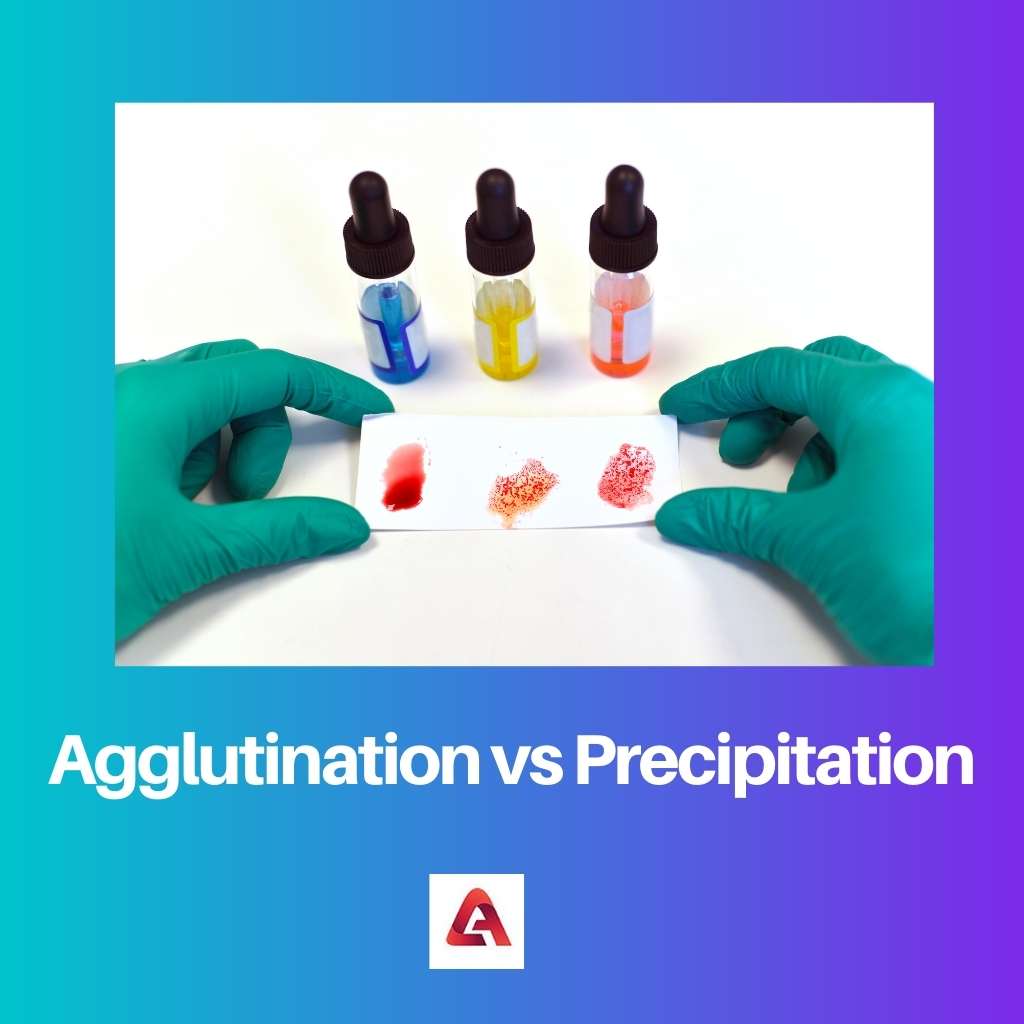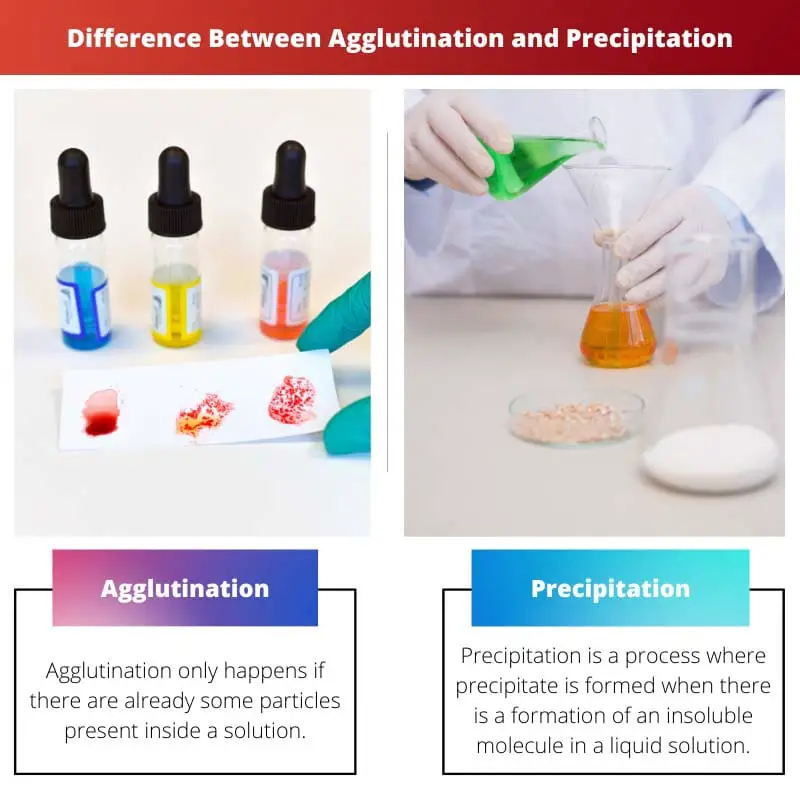The solution is a mixture that consists of two or more two substances. It is a homogenous mixture. A solute is a substance that gets dissolved in a solvent.
Like sugar is a solute, and water is a solvent. When solute gets dissolved in a solution, it cannot be seen with bare eyes.
The solution is a stable thing and cannot be filtered. It occurs in only one phase.
Agglutination and Precipitation form a solid mass inside a solution. This solid mass can either get dissolved or will stay in suspension.
Both are very different processes that happen due to complex chemical reactions.
Key Takeaways
- Agglutination is the process of clumping particles, whereas precipitation is the process of settling particles.
- Agglutination reactions involve antigens and antibodies binding together, while precipitation reactions involve the formation of a solid precipitate.
- Agglutination is commonly used in blood typing and diagnosis of diseases, while precipitation is commonly used in wastewater treatment and laboratory experiments.
Agglutination vs Precipitation
Agglutination is the process by which particles, like bacteria or red blood cells, clump together in the presence of antibodies. Precipitation is the process by which soluble antigens and antibodies combine to form insoluble complexes, which can then be visualized as a cloudy or opaque precipitate.

Agglutination means when there is an accumulation of particles or when the particles get clumped together. When an antigen is mixed with its antibody, it is called isoagglutinin.
The term isoagglutinin is a ubiquitous term in blood grouping when all the particles accumulate to form a single large mass.
That mass will either stay in suspension or will sink in the bottom but not get dissolved. The end product is always aggregated.
Agglutination only happens if there are already some particles present inside a solution.
Precipitation is a process where a precipitate is formed when there is a formation of an insoluble molecule in a liquid solution.
The chemical reagent responsible for leading the reaction and turning it into a solid mass is called a residue. The liquid that is above the sediment is clear and is called supernate.
Precipitation can be applied to other fields besides chemistry like it can be used in alloys and metallurgy to remove the solid impurities from the solid phase.
Precipitation depends upon factors like temperature change, mixing solvents, evaporation of solvents etc.
Comparison Table
| Parameters of Comparison | Agglutination | Precipitation |
|---|---|---|
| Size | Smaller antigen | Larger antigen |
| Solubility | Sedimented | Soluble |
| Types | Active and passive agglutination | Precipitation in solution, precipitation in diffusion and electrophoresis. |
| Uses | Blood Grouping | Quantitative analysis, Pigment formation etc. |
| Matrix | microtitre plate, glass slides and test tubes. | Test tubes, glass slides, Petri plates. |
What is Agglutination?
Agglutination was discovered by two bacteriologists, namely Herbert Edward Durham and Max von Gruberin 1896. Gruber was the one who gave the term agglutinin.
Together the clumping process was called the Gruber-Durham reaction. Agglutination was first used as a base for a test for typhoid fever.
This kind of test was the first that helped in the serum diagnosis. Karl Landsteiner was another physician who, in 1900, discovered another practical application of Agglutination that led to the discovery of the ABO blood group.
This helped humanity to start the process of blood transfusion and serology.
Agglutination is also called the antigen-antibody process, where the soluble antigen reacts with antibodies to form agglutinin. It is a sophisticated and sensitive process as it requires the handling of particulate antigens.
Particles present in the solution in the process of Agglutination are the starting product. Agglutination forms a solid mass in the resolution, and unlike precipitation, it sinks at the bottom of the container.
A smaller size of compounds is needed to carry out the process of Agglutination. The reaction of Agglutination takes place in a broad spectrum.
Because there is clumping and cross-linkage between the particles and antibodies, the end product in Agglutination can appear as large aggregates.
It is straightforward to perform Agglutination. They are soluble as well.
What is Percipitation?
Precipitation is a chemical reaction linked with the antibody to form ions in solid form. The product developed is called a residue.
When soluble salts are bound together to form an insoluble precipitate in an aqueous solution, it is called Precipitation. The reaction occurring between salts and ionic compounds also results in precipitation.
Antigen in precipitation is more significant and more prominent. The resulting or the end product is called precipitin.
Precipitation is used in many processes, like quantitative analysis, water treatment techniques, and pigment formation. Solubility of Precipitation is insoluble. Precipitation needs gel or any liquid to happen.
The precipitation reaction can be performed on glass tubes, test tubes, or Petri dishes. The end product in Precipitation is visible in the form of crystalline ionic solids.
Valency plays an essential role in taking up precipitation. If both antigen and antibody are bivalent or polyvalent, the reaction will occur. It takes place when both are in equivalence.
If there is excess or deficit in antigen or antibody, precipitation will not occur. It is used in analytical chemistry to detect various chemical substances.
Main Differences Between Agglutination and Precipitation
- In Aggulitination, the size of the antigen is smaller. In precipitation, the size of the antigen is larger.
- An antigen is sedimented in the form of Agglutination. An antigen is in soluble form in precipitation.
- Types of Agglutination include active and passive Agglutination. Types of Precipitation have precipitation in solution, precipitation in diffusion and electrophoresis.
- The use of Agglutination is blood grouping. The uses of precipitation are quantitative analysis, water treatment techniques, and pigment formation.
- Agglutination can be performed on glass slides, test tubes and microtitre plates. Precipitation can be performed on Petri places, glass sides and test tubes.

- https://www.jimmunol.org/content/18/5/393.short
- https://rupress.org/jem/article-abstract/46/2/303/9635